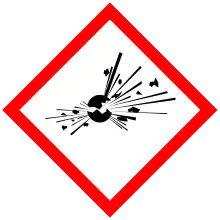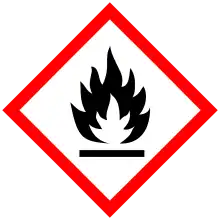A flammable liquid is a liquid with flash point of not more than 60.5 °C (141 °F), or any material in a liquid phase with a flash point at or above 37.8 °C (100 °F) that is intentionally heated and offered for transportation or transported at or above its flash point in a bulk packaging.
Divisions
Class 3: Flammable Liquids
A flammable liquid is a liquid having a flash point of not more than 60 °C (140 °F), or any material in a liquid phase with a flash point at or above 37.8 °C (100 °F) that is intentionally heated and offered for transportation or transported at or above its flash point in a bulk packaging. The following exceptions apply:
- Any liquid meeting one of the definitions specified in 49CFR 173.115.
- Any mixture having one or more components with a flash point of 60.5 °C (141 °F) or higher, that make up at least 99 percent of the total volume of the mixture, if the mixture is not offered for transportation or transported at or above its flash point.
- Any liquid with a flash point greater than 35 °C (95 °F) which does not sustain combustion according to ASTM 4206 or the procedure in Appendix H of this part.
- Any liquid with a flash point greater than 35 °C (95 °F) and with a fire point greater than 100 °C (212 °F) according to ISO 2592.
- Any liquid with a flash point greater than 35 °C (95 °F) which is in a water-miscible solution with a water content of more than 90 percent by mass.
Flash Point: The flash point is the minimum temperature at which a liquid gives off vapor within a test vessel in sufficient concentration to form an ignitable mixture with air near the surface of the liquid.
Placards
|
|
| |||||||||
|
Alternate Placards and Labeling
- Combustible Liquids:
- A combustible liquid means any liquid that does not meet the definition of any other hazard class specified in this subchapter and has a flash point above 60.5 °C (141 °F) and below 93 °C (200 °F).
- A flammable liquid with a flash point at or above 38 °C (100 °F) that does not meet the definition of any other hazard class may be reclassed as a combustible liquid. This provision does not apply to transportation by vessel or aircraft, except where other means of transportation is impracticable. An elevated temperature material that meets the definition of a Class 3 material because it is intentionally heated and offered for transportation or transported at or above its flash point may not be reclassed as a combustible liquid.
- A combustible liquid which does not sustain combustion is not subject to the requirements of this subchapter as a combustible liquid. Either the test method specified in ASTM 4206 or the procedure in Appendix H of this part may be used to determine if a material sustains combustion when heated under test conditions and exposed to an external source of flame.
- Gasoline: This placard is an alternative placard, which may be used for gasoline in non-bulk quantities.
- Fuel Oil: This placard is an alternative placard, which may be used for fuel oil in non-bulk quantities.
Compatibility Table
| Load and Segregation Chart | |||||||||||||||||||||
|---|---|---|---|---|---|---|---|---|---|---|---|---|---|---|---|---|---|---|---|---|---|
| Weight | 1.1 | 1.2 | 1.3 | 1.4 | 1.5 | 1.6 | 2.1 | 2.2 | 2.2 | 2.3 | 3 | 4.1 | 4.2 | 4.3 | 5.1 | 5.2 | 6.1 | 7 | 8 | ||
| A | B | A | |||||||||||||||||||
| 3 | 1,001 lb (454 kg) | O | O | O | |||||||||||||||||
| Key | |||||||||||||||||||||
| The absence of any hazard class or division or a blank space in the table indicates that no restrictions apply.
| |||||||||||||||||||||
Packing Groups
| Class 3 Packing Groups | ||
|---|---|---|
| Packing Group | Flash Point (Closed-Cup) |
Initial Boiling Point |
| I | <=35°C (95°F) | |
| II | <23°C (73°F) | >35°C (95°F) |
| III | >=23°C, <=60°C (140°F) | >35°C (95°F) |
References
- 49 CFR 173.120 (U.S. Code)
- 49 CFR 173.120(a) (U.S. Code)
- 49 CFR 173.120(b)(1) (U.S. Code)
- ↑ Pipeline and Hazardous Materials Safety Administration (PHMSA) (October 1, 2011). "49 CFR 177.848 - Segregation of hazardous materials" (PDF). Government Publishing Office. p. 853. Archived from the original (PDF) on 16 July 2019. Retrieved 16 July 2019.
.svg.png.webp)
.svg.png.webp)
.svg.png.webp)
.svg.png.webp)


